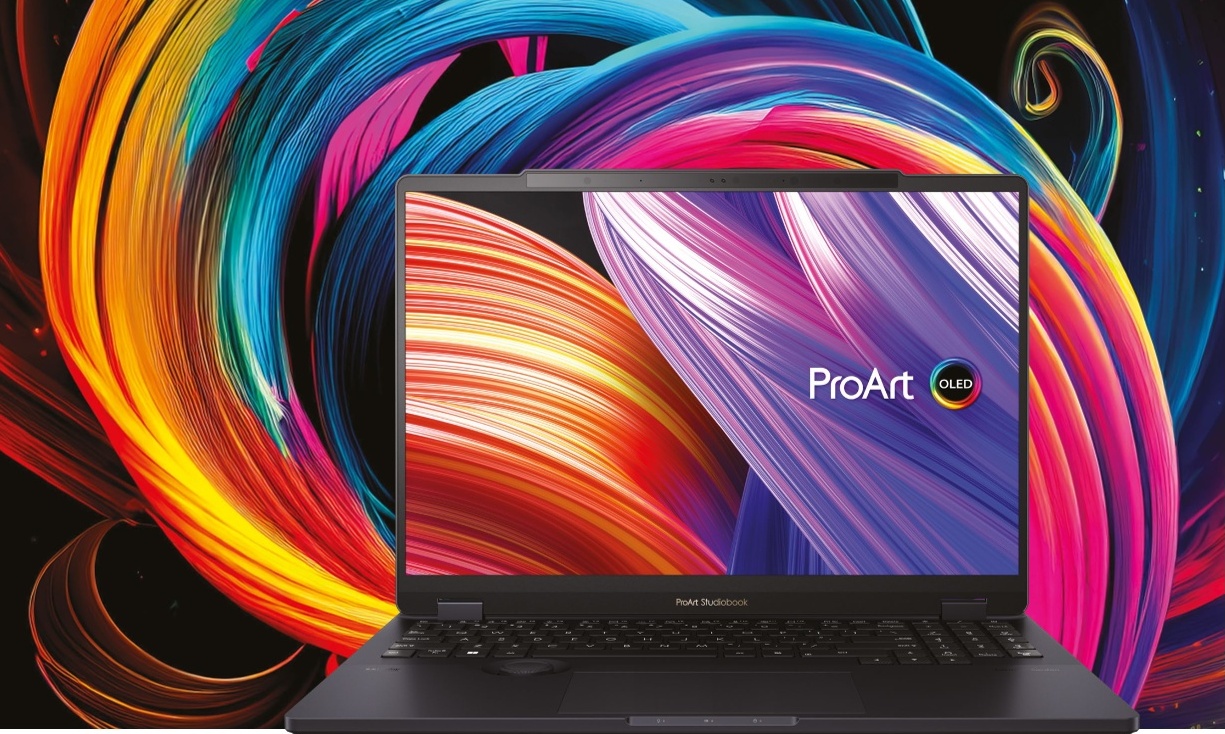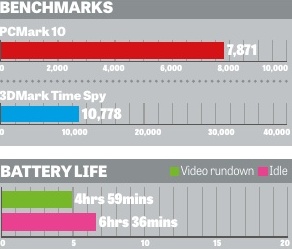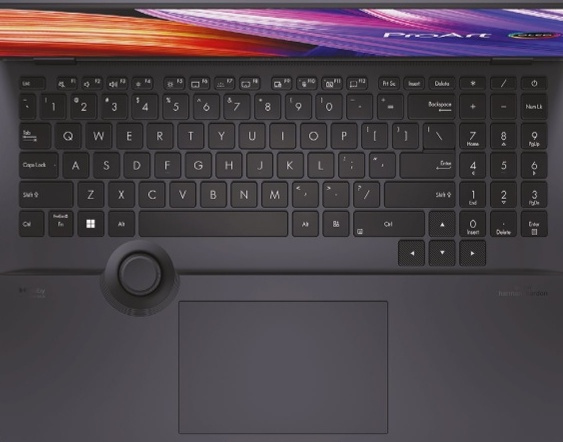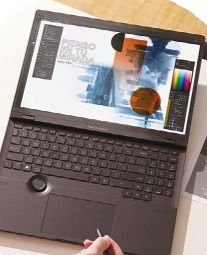Why you can trust TechRadar
This review first appeared in issue 346 of PC Pro.
The first version of the ProArt Studiobook 16 OLED was one impressive beast. Not content with whacking in a cutting-edge AMD Ryzen processor and GeForce RTX 3070 graphics, it offered the novel combination of a built-in dial and glorious 16in OLED panel. This year’s update isn’t radical, but improvements all round make it even more appealing to the creative professionals that Asus is targeting.
I have only one disappointment: at the time that Asus announced this update, it also shared details of a 3D version of the laptop. Just like the Acer SpatialLabs View screens I reviewed two months ago, the ProArt Studiobook 16 3D OLED (note the “3D”) creates stereoscopic 3D images without the need for glasses. Such technology works fantastically, using eye-tracking software and micro lenses to beam slightly different images to each eye. When you want to switch back to 2D, it only takes one click.
Sadly, if that appeals then you must wait for a launch “later this year”. For now, you must make do with the non-3D version. And you will need to still wait until mid-June for that, at which point it will become available from Scan (code LN135615).

Screening success
In terms of color accuracy and coverage, Asus throws everything it can at the screens in its ProArt range. Here, that includes Calman Verified and Pantone Validated certifications, with the guarantee that each panel’s average Delta E (a measure of color accuracy) will be under two. Our panel’s accuracy was even better: it averaged 0.51 and had a maximum Delta E of 1.12.
Color coverage is superb, too. You have a choice of color profiles, including DCI-P3, where it covered 99% of the gamut. Print designers who prefer to work in the Adobe RGB space should stick to the Native profile, with 98% coverage.
But what really matters about this OLED panel is that it’s gorgeous. You benefit from incredible sharpness thanks to a resolution of 3,200 x 2,000, and whether you’re watching a film or editing photos you’ll fall in love with the rich colors and deep blacks. While a peak brightness of 363cd/m2 may not sound noteworthy, support for DisplayHDR’s True Black 500 shows that it can go higher in localized areas in supported content.

Gaming prowess
That includes games, and with a 120Hz refresh rate and 0.2ms response time there’s much here for gamers to love. The Studiobook ships with Nvidia’s Studio drivers rather than its Game Ready option, but it’s easy enough to switch if gaming is your preference.
Its results in our 1080p gaming benchmark suite were predictably high: 186fps in F1 22, 144fps in Shadow of the Tomb Raider, 101fps in Metro Exodus and 88fps in Metro Exodus Enhanced Edition. Those are all at High settings. Switching to the native resolution of 3,200 x 2,000 saw those figures drop to 105fps, 94fps, 56fps and 45fps.
All our results were with the Studio drivers and the laptop in “MSHybrid” mode, where it automatically switches between discrete and integrated graphics. You can choose to use only the discrete GPU, but that made no difference to our results so I suggest sticking with the default.
Not least because using integrated graphics will squeeze some extra life from the 90W battery. The Studiobook is a power-hungry beast, and the best result I saw was in PCMark’s idle test where it kept going for 6hrs 36mins. It lasted around five hours in both the video-rundown and light-use office tests, while switching to gaming reduced life to a mere 1hr 34mins. Those results are typical of a Windows workstation such as this, but the 16in MacBook Pro lasted for almost 20 hours in our video-rundown test.

Power on tap
Portability is hardly this product’s forte anyway. Quite aside from the 2.4kg weight of the laptop, you should allow for the 740g power supply. In return for the bulk, however, you’re buying an incredibly powerful system. Let’s start with a Core i9-13980HX processor, complete with eight P-cores that max out at 5.6GHz and 16 E-cores with a peak 4GHz frequency. That’s 32 threads ready to tackle any suitable task, which is why it reached 24,801 in Cinebench R23 and 21,043 in Geekbench 5. The MacBook Pro, by contrast, scored 14,700 and 15,061 in those tests.
Mind you, the Studiobook has the advantage of 64GB of DDR5-5200 RAM to the MacBook’s 32GB. And having two M.2 Gen4 SSDs in a RAID0 configuration is never going to hurt: these scorched through CrystalMark 8’s sequential tests with 7,015MB/sec reads and 6,431MB/sec writes. The only downside, especially compared to MacBooks powered by Apple’s M2 chips, is that the fans kick in as soon as tasks become demanding.
You can admire those fans for yourself by removing the ten Torx screws that secure the base. Doing so reveals how easy it will be to replace the memory and SSDs should the need ever arise; not something that’s possible to do on the latest MacBooks.

Touching interface
Asus also leans into another advantage of Windows laptops: support for touch. The screen is responsive to fingers, of course, but Asus includes one of its active styluses in the box. This works on the touchpad too, so it’s a shame that this isn’t even bigger. Still, a 6in diagonal provides room to play, and the haptic technology built in works brilliantly.
Then there’s the Asus Dial. Invest time to learn how it works and this could become an integral part of your daily workflow. Especially if you use Adobe’s Creative Cloud: the dial can scrub through timelines in Adobe Premiere Pro, adjust brush sizes in Photoshop and make minute adjustments in Lightroom. Anything where it’s useful to make granular or sweeping changes.
It’s also possible to put the Asus Dial to use in Windows and other apps, perhaps to adjust the volume, brightness and cycle through open tabs in your web browser. It’s hard to imagine these will make a great deal of difference to your daily life, though, so the dial is most useful if you’re using creative tools on a daily basis.

One minor annoyance is that you must load up two different Asus tools to tweak settings. There’s the ProArt Creator Hub, where you control the dial settings and access calibration tools for the screen. But you also have MyAsus, which offers a bunch more options – some of which, such as switching between performance modes, are duplicated in the ProArt Creator Hub. Both have different aesthetics, so they clearly haven’t been designed by the same teams.
When it comes to the hardware’s aesthetics, though, I have no criticisms. There’s none of the RGB bling found on many Asus gaming laptops, just a sleek and understated design. The metal lid is unadorned by fussy logos, with a subtle “ProArt” the only branding on show. It’s even covered with anti-fingerprint coating to keep the black finish looking swish.
This is one solidly built laptop, too, with Gorilla Glass to protect the screen and the promise of testing to military grade standards. These include shock, vibration and extreme temperatures. Nor can I complain about connectivity, with a generous helping of ports – including two Thunderbolt 4 and 2.5Gb Ethernet – and Wi-Fi 6E. And both the 1080p webcam and the speakers are from the top-quality drawer.

Final thoughts
This is a great update to the Studiobook and one that should particularly appeal to 3D designers – when that model becomes available. It will then be possible to rapidly iterate through prototypes: design, get feedback, tweak. If you can take advantage of the Asus Dial, the stylus and the sheer firepower within this laptop, then it could be a transformative purchase.
For everyone else, it’s probably overkill. Especially at this price. But if you like the idea of the integrated dial, then Google for “ProArt Studiobook 16 OLED” and you’ll find cheaper options based on last year’s silicon.
The ProArt Studiobook 16 OLED has a unique design, and if you need its skillset then you can be assured of top components and build quality throughout.
We also ranked the best free Adobe Illustrator alternatives.
Tim Danton is editor-in-chief of PC Pro, the UK's biggest selling IT monthly magazine. He specialises in reviews of laptops, desktop PCs and monitors, and is also author of a book called The Computers That Made Britain.
You can contact Tim directly at editor@pcpro.co.uk.
What is a hands on review?
Hands on reviews' are a journalist's first impressions of a piece of kit based on spending some time with it. It may be just a few moments, or a few hours. The important thing is we have been able to play with it ourselves and can give you some sense of what it's like to use, even if it's only an embryonic view. For more information, see TechRadar's Reviews Guarantee.
You must confirm your public display name before commenting
Please logout and then login again, you will then be prompted to enter your display name.

